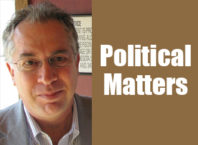By Mordecai Specktor
Reflections on Turkey Day
My family moved up the Thanksgiving festivities by a week, so our son Max, who was visiting from Copenhagen, could enjoy the traditional turkey and side dishes before his return to Denmark.
Over recent years, the National Day of Mourning has been observed by many Native people who have learned that the dominant American holiday is “rooted in historical fallacy and upholds tired settler colonial belief systems,” in the words of the hosts of the “All My Relations Podcast.”
The Nov. 20 podcast episode (bit.ly/amr-thanksgiving), hosted by Matika Wilbur and Adrienne Keene, is titled “ThanksTaking or ThanksGiving?” The program features an illuminating discussion of the national holiday, featuring Wampanoag scholars Paula Peters and Linda Coombs.
The previously mentioned National Day of Mourning was born in 1970, when a Massachusetts civic celebration of the 350th anniversary of the Pilgrims’ arrival ran into a snag. The Commonwealth of Massachusetts intended to celebrate amity between their ancestors and the Wampanoag; but Wamsutta (aka Frank James), a Wampanoag leader invited to speak, was disinvited by planning committee members, who deemed his remarks as “inflammatory” and contrary to the anniversary celebration’s theme of “brotherhood.”
Wamsutta and his supporters shunned the civic celebration and assembled at nearby Cole’s Hill. He gave the speech that he intended to deliver about the depredations of the Pilgrims (grave robbing, stealing food stores, enslaving Native people, etc.), near the statue of Massasoit, who was the Wampanoag’s leader when the Pilgrims landed, and thus kicked off the first National Day of Mourning.
This reexamination of the past has accelerated in 2020, the year from hell, as statues of genocidal explorers and slave owners – Columbus, George Washington, et al. – have been toppled. If we are to go forward as a society, a reckoning with mythologies is necessary, in part, as an antidote to the right-wing movement of self-proclaimed patriots threatening to pull us back to an imagined era of American greatness.
I recently signed an online petition to rename my high school, which is now called Henry Sibley (it was just Sibley High School when I graduated in 1968). There’s no compelling reason to continue honoring Minnesota’s first governor, who played a key role in the U.S.-Dakota War and the country’s largest mass execution, the hanging of 38 Dakota men in Mankato, on Dec. 26, 1862. Sibley’s military commission sought to execute 303 Dakotas, but Pres. Abraham Lincoln pared down the list.
My alma mater certainly can find a person more deserving of recognition. Perhaps, the school should be named after Dakota leader Taoyateduta (Little Crow).
The Native vote
The Nov. 3 elections provided a sense of relief. Eventually, as the votes were counted in key battleground states, we learned that Donald Trump would soon pack up his Twitter device and move out of 1600 Pennsylvania Avenue.
Political observers have noted that Trump’s abdication of responsibility to stop the spread of SARS-CoV-2, the virus that causes COVID-19, contributed to his failed reelection bid.
My wife (who became a U.S. citizen last year) and I live in a deep blue precinct in South Minneapolis, where DFL candidates routinely reap 80 to 90 percent of the vote. (I refer to the neighborhood as the People’s Republic of Powderhorn Park.) And there were similar results this year from precincts around the Red Lake Reservation, in Beltrami County, according to an analysis by the Star Tribune.
In four precincts around Red Lake – where voter participation increased from 22 to 45 percent from 2016 to 2020 – the Biden-Harris ticket got more than 90 percent of the vote. “A similar pattern played out in precincts on or around Native American reservations across northern Minnesota – blips of deep blue in the middle of red Trump country,” according to the newspaper.
There likely was a prime reason for the rise in voter participation in predominantly American Indian precincts and the blue vote.
Nancy Beaulieu, an organizer for the clean-energy group MN350, told the Star Tribune: “You know why they showed up? Trump. They didn’t believe in the DFL Party. They didn’t believe Joe Biden was the best candidate for us. They wanted to vote against Trump.”
This trend was replicated across Indian Country. The Nov. 21 Star Tribune story mentioned that in other battleground states, “Native American voters turned out in record numbers, including Arizona, where Biden leads Trump by 11,000 votes. Native voter turnout may have also tipped the scales in neighboring Wisconsin, where the National Congress of American Indians estimates there are about 71,000 voting-age Native Americans. Biden won the state by about 20,000 votes, pending a recount.





